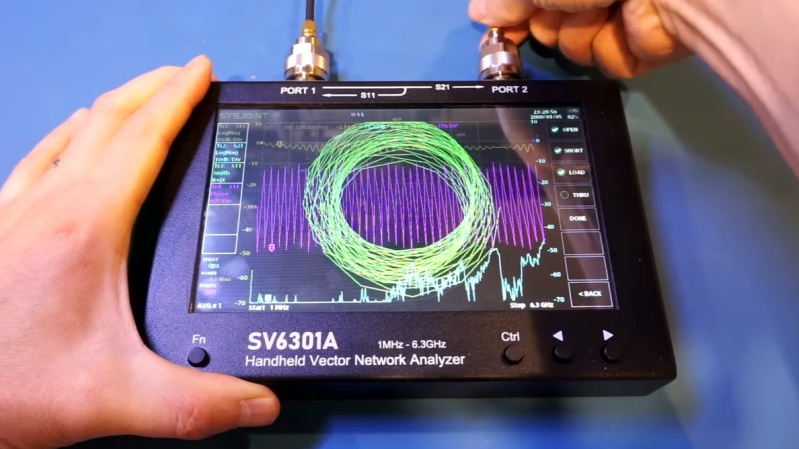[Kerry Wong], ever interested in trying out and tearing down electrical devices, demonstrates and examines the SV 6301a Handheld Vector Network Analyzer. He puts the machine through its paces, noting that the 7 inch touchscreen is a pretty nice feature for those whose eyesight isn’t quite what it used to be.

What’s a Vector Network Analyzer (VNA)? It’s not for testing Ethernet or WiFi. It’s aimed at a more classical type of “network”. The VNA tests and evaluates characteristics of electrical networks, especially as related to RF and microwave.
It provides detailed information about properties across a specified frequency range, making it an indispensable tool for advanced work. Tektronix has a resource page that goes into detail about exactly what kinds of things a VNA is good for.
[Kerry] shows off a few different features and sample tests before pulling the unit apart. In the end, he’s satisfied with the features and performance of the device, especially the large screen and sensible user interface.
After all, not every piece of test equipment does a great job at fulfilling its primary function, like the cheap oscilloscope that was a perhaps a little too cheap.
















Sounds interesting and i would love to look at the linked website of this guy, BUT WHY ON EARTH is it not only not accessible over https but ALSO does include javascript from at least 10(!) different domains, including some big data collectors??? Sorry, no! Fail.
I’m going to guess… doesn’t believe in wasting electricity and clock cycles encrypting data that he is intentionally sharing with anyone and everyone that wants it anyway. Very environmentally responsible for this day and age! It’s good to see there are at least a few who are immune to the SSL-Everywhere mind virus. I mean, I’m all for not just offering but requiring SSL as soon as you are giving out logins, collecting any sort of data from the user or sharing any sort of secrets with only select users. But for an informational blog SSL is a pretty dumb waste of resources.
For the javascript… I’ll guess using 3rd party activity analysis, effects libraries or maybe even trying to make a penny off of advertising. Pretty common stuff among amateurs even if it is kind of icky.
A site that includes javascript from doubleclick.net, google.com, facebook.com, googlesyndication.com, gstatic.com, jnn-pa.googleapis.com, linkedin.com, stumbleupon.com, twitter.com and youtube.com wants to make money, the content is just a side effect. Real amateurs create nice websites without all that data exfiltration junk.
So you are saying webmasters should enter their passwords over plaintext? Because that’s what that site is requiring for editing.
Note in addition many optimizations are left off the table because web browsers won’t talk HTTP2 or QUIC/HTTP3 over plaintext.
Not used for testing Ethernet is not entirely accurate.
VNAs are also used for testing ethernet cabling to ISO 11801 (and TIA-568) as they can characterise return loss, insertion loss, and crosstalk.
Totally! Like adsl is basically an RF protocol??
This article gives pretty much no information about what a VNA actually is, just a load of waffle about what it does without actually saying anything meaningful. I know a page was linked but is it really that hard to include a paragraph, probably in place of the waffle, that just says what it does and a few common use cases?
There is practically zero useful information in this article, just a lot of filler, a link to other pages for explanations and the video. If you are going to write an article then make it worthwhile to read and actually add something to the content the article is about.
“What’s a Vector Network Analyzer (VNA)? It’s not for testing Ethernet or WiFi.”
Sure it is! Try lookind at IQ eye-closure as a measure of Eb/No versus BER. Very useful.
As for [Kerry Wong]… When are you FINALLY going to do the right thing and help the World resurrect even a fraction of the millions of abandoned Chumby devices you helped stick us with?
The SYSJOINT web site link for the SV6301A VNA is struggling right now (Hackaday effect?) Try starting from the home page:
https://www.sysjoint.com/?lang=en